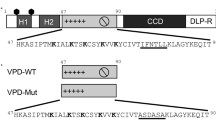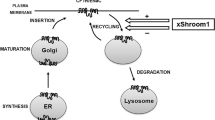Abstract
The Alphavirus Sindbis 6K protein is involved in several functions. It contributes to the processing and membrane insertion of E1 and PE2 viral envelope glycoproteins and to virus budding. It also permeabilizes Escherichia coli and mammalian cells. These viroporin-like properties have been proposed to help virus budding by modifying membrane permeabilities. We expressed Sindbis virus 6K cRNA in Xenopus oocytes to further characterize the effect of 6K on membrane conductances and permeabilization. Although no intrinsic channel properties were seen, cell shrinkage was observed within 24 h. Voltage-clamp experiments showed that 6K upregulated endogenous currents: a hyperpolarization-activated inward current (I in) and a calcium-dependent chloride current (I Cl). 6K was located at both the plasma and the endoplasmic reticulum membranes. The plasma membrane current upregulation likely results from disruption of the calcium homeostasis of the cell at the endoplasmic reticulum level. Indeed, 6K cRNA expression induced reticular calcium store depletion and capacitative calcium entry activation. By experimental modifications of the incubation medium, we showed that downstream of these events cell shrinkage resulted from a 6K -induced KCl efflux (I Cl upregulation leads to chloride efflux, which itself electrically drives potassium efflux), which was responsible for an osmotic water efflux. Our data confirm that 6K specifically triggers a sequential cascade of events that leads to cytoplasmic calcium elevation and cell permeabilization, which likely play a role in the Sindbis virus life cycle.






Similar content being viewed by others
References
Aldabe R, Irurzun A, Carrasco L (1997) Poliovirus protein 2BC increases cytosolic free calcium concentrations. J Virol 71:6214–6217
Amasheh S, Weber W (1999) Further characteristics of the Ca2+-inactivated Cl− channel in Xenopus laevis oocytes. J Membr Biol 172:169–179
Bianchi L, Gerstbrein B, Frokjaer-Jensen C, Royal DC, Mukherjee G, Royal MA, Xue J, Schafer WR, Driscoll M (2004) The neurotoxic MEC-4(d) DEG/ENaC sodium channel conducts calcium: Implications for necrosis initiation. Nat Neurosci 7:1337–1344
Burgoyne RD, O’Callaghan DW, Hasdemir B, Haynes LP, Tepikin AV (2004) Neuronal Ca2+-sensor proteins: Multitalented regulators of neuronal function. Trends Neurosci 27:203–209
Caillian K, Perdereau D, Lescuyer A, Chen H, Garbay C, Vilain JP, Burol AF, Browaeys-Poly E (2005) FGF receptor phosphotyrosine 766 is a target for Grb14 to inhibit MDA-MB-231 human breast cancer cell signaling. Anticancer Res 25:3877–3882
Carrasco L (1995) Modification of membrane permeability by animal viruses. Adv Virus Res 45:61–112
Carrere-Kremer S, Montpellier C, Lorenzo L, Brulin B, Cocquerel L, Belouzard S, Penin F, Dubuisson J (2004) Regulation of hepatitis C virus polyprotein processing by signal peptidase involves structural determinants at the p7 sequence junctions. J Biol Chem 279:41384–41392
Cheshenko N, Del Rosario B, Woda C, Marcellino D, Satlin LM, Herold BC (2003) Herpes simplex virus triggers activation of calcium-signaling pathways. J Cell Biol 163:283–293
Coady MJ, Daniel NG, Tiganos E, Allain B, Friborg J, Lapointe JY, Cohen EA (1998) Effects of Vpu expression on Xenopus oocyte membrane conductance. Virology 244:39–49
Cooper GJ, Fong P (2003) Relationship between intracellular pH and chloride in Xenopus oocytes expressing the chloride channel ClC-0. Am J Physiol 284:C331–C338
Ewart GD, Sutherland T, Gage PW, Cox GB (1996) The Vpu protein of human immunodeficiency virus type 1 forms cation-selective ion channels. J Virol 70:7108–7115
Fischer WB, Pitkeathly M, Wallace BA, Forrest LR, Smith GR, Sansom MS (2000) Transmembrane peptide NB of influenza B: A simulation, structure, and conductance study. Biochemistry 39:12708–12716
Garoff H, Wilschut J, Liljestrom P, et al. (1994) Assembly and entry mechanisms of Semliki Forest virus. Arch Virol Suppl 9:329–338
Gillo B, Chorna I, Cohen H, Cook B, Manistersky I, Chorev M, Arnon A, Pollock JA, Selinger Z, Minke B (1996) Coexpression of Drosophila TRP and TRP-like proteins in Xenopus oocytes reconstitutes capacitative Ca2+ entry. Proc Natl Acad Sci USA 93:14146–14151
Gonzalez ME, Carrasco L (2003) Viroporins. FEBS Lett 552:28–34
Griffin DE, Byrnes AP, Cook SH (2004) Emergence and virulence of encephalitogenic arboviruses. Arch Virol Suppl 18:21–33
Griffin SD, Beales LP, Clarke DS, Worsfold O, Evans SD, Jaeger J, Harris MP, Rowlands DJ (2003) The p7 protein of hepatitis C virus forms an ion channel that is blocked by the antiviral drug, Amantadine. FEBS Lett 535:34–38
Irurzun A, Arroyo J, Alvarez A, Carrasco L (1995) Enhanced intracellular calcium concentration during poliovirus infection. J Virol 69:5142–5146
Kelly ML, Cook JA, Brown-Augsburger P, Heinz BA, Smith MC, Pinto LH (2003) Demonstrating the intrinsic ion channel activity of virally encoded proteins. FEBS Lett 552:61–67
Kuruma A, Hartzell HC (1999) Dynamics of calcium regulation of chloride currents in Xenopus oocytes. Am J Physiol 276:C161–C175
Kuruma A, Hartzell HC (2000) Bimodal control of a Ca2+-activated Cl− channel by different Ca2+ signals. J Gen Physiol 115:59–80
Kuruma A, Hirayama Y, Hartzell HC (2000) A hyperpolarization- and acid-activated nonselective cation current in Xenopus oocytes. Am J Physiol 279:C1401–C1413
Lama J, Carrasco L (1992a) Expression of poliovirus nonstructural proteins in Escherichia coli cells. Modification of membrane permeability induced by 2B and 3A. J Biol Chem 267:15932–15937
Lama J, Carrasco L (1992b) Inducible expression of a toxic poliovirus membrane protein in Escherichia coli: Comparative studies using different expression systems based on T7 promoters. Biochem Biophys Res Commun 188:972–981
Liljestrom P, Garoff H (1991) Internally located cleavable signal sequences direct the formation of Semliki Forest virus membrane proteins from a polyprotein precursor. J Virol 65:147–154
Lusa S, Garoff H, Liljestrom P (1991) Fate of the 6K membrane protein of Semliki Forest virus during virus assembly. Virology 185:843–846
Machaca K, Haun S (2000) Store-operated calcium entry inactivates at the germinal vesicle breakdown stage of Xenopus meiosis. J Biol Chem 275:38710–38715
Melton JV, Ewart GD, Weir RC, Board PG, Lee E, Gage PW (2002) Alphavirus 6K proteins form ion channels. J Biol Chem 277:46923–46931
Nokta M, Eaton D, Steinsland OS, Albrecht T (1987) Ca2+ responses in cytomegalovirus-infected fibroblasts of human origin. Virology 157:259–267
Osman AA, Saito M, Makepeace C, Permutt MA, Schlesinger P, Mueckler M (2003) Wolframin expression induces novel ion channel activity in endoplasmic reticulum membranes and increases intracellular calcium. J Biol Chem 278:52755–52762
Paterson RG, Takeda M, Ohigashi Y, Pinto LH, Lamb RA (2003) Influenza B virus BM2 protein is an oligomeric integral membrane protein expressed at the cell surface. Virology 306:7–17
Pavlovic D, Neville DC, Argaud O, Blumberg B, Dwek RA, Fischer WB, Zitzmann N (2003) The hepatitis C virus p7 protein forms an ion channel that is inhibited by long-alkyl-chain iminosugar derivatives. Proc Natl Acad Sci USA 100:6104–6108
Perez JF, Ruiz MC, Chemello ME, Michelangeli F (1999) Characterization of a membrane calcium pathway induced by rotavirus infection in cultured cells. J Virol 73:2481–2490
Piller SC, Jans P, Gage PW, Jans DA (1998) Extracellular HIV-1 virus protein R causes a large inward current and cell death in cultured hippocampal neurons: implications for AIDS pathology. Proc Natl Acad Sci USA 95:4595–4600
Pinto LH, Holsinger LJ, Lamb RA (1992) Influenza virus M2 protein has ion channel activity. Cell 69:517–528
Plugge B, Gazzarrini S, Nelson M, Cerana R, Van Etten JL, Derst C, DiFrancesco D, Moroni A, Thiel G (2000) A potassium channel protein encoded by chlorella virus PBCV-1. Science 287:1641–1644
Premkumar A, Wilson L, Ewart GD, Gage PW (2004) Cation-selective ion channels formed by p7 of hepatitis C virus are blocked by hexamethylene amiloride. FEBS Lett 557:99–103
Rice CM, Levis R, Strauss JH, Huang HV (1987) Production of infectious RNA transcripts from Sindbis virus cDNA clones: Mapping of lethal mutations, rescue of a temperature-sensitive marker, and in vitro mutagenesis to generate defined mutants. J Virol 61:3809–3819
Roth MB, Zahler AM, Stolk JA (1991) A conserved family of nuclear phosphoproteins localized to sites of polymerase II transcription. J Cell Biol 115:587–596
Sanderson CM, Parkinson JE, Hollinshead M, Smith GL (1996) Overexpression of the vaccinia virus A38L integral membrane protein promotes Ca2+ influx into infected cells. J Virol 70:905–914
Sanz MA, Madan V, Carrasco L, Nieva JL (2003) Interfacial domains in Sindbis virus 6K protein. Detection and functional characterization. J Biol Chem 278:2051–2057
Sanz MA, Perez L, Carrasco L (1994) Semliki Forest virus 6K protein modifies membrane permeability after inducible expression in Escherichia coli cells. J Biol Chem 269:12106–12110
Schubert U, Ferrer-Montiel AV, Oblatt-Montal M, Henklein P, Strebel K, Montal M (1996) Identification of an ion channel activity of the Vpu transmembrane domain and its involvement in the regulation of virus release from HIV-1-infected cells. FEBS Lett 398:12–18
Shainkin-Kestenbaum R, Winikoff Y, Chaimovitz C, Zimlichman S, Sarov I (1993) Inhibitory effect of the calcium antagonist, verapamil, on measles and vaccinia replication in cell culture. Isr J Med Sci 29:2–6
Shimbo K, Brassard DL, Lamb RA, Pinto LH (1995) Viral and cellular small integral membrane proteins can modify ion channels endogenous to Xenopus oocytes. Biophys J 69:1819–1829
Strauss JH, Strauss EG (1994) The alphaviruses: Gene expression, replication, and evolution. Microbiol Rev 58:491–562
Sunstrom NA, Premkumar LS, Premkumar A, Ewart G, Cox GB, Gage PW (1996) Ion channels formed by NB, an influenza B virus protein. J Membr Biol 150:127–132
Tang CY, Chen YW, Jow GM, Chou CJ, Jeng CJ (2005) Beauvericin activates Ca2+-activated Cl− currents and induces cell deaths in Xenopus oocytes via influx of extracellular Ca2+. Chem Res Toxicol 18:825–833
Tzounopoulos T, Maylie J, Adelman JP (1995) Induction of endogenous channels by high levels of heterologous membrane proteins in Xenopus oocytes. Biophys J 69:904–908
van Kuppeveld FJ, Hoenderop JG, Smeets RL, Willems PH, Dijkman HB, Galama JM, Melchers WJ (1997) Coxsackievirus protein 2B modifies endoplasmic reticulum membrane and plasma membrane permeability and facilitates virus release. EMBO J 16:3519–3532
Weber WM, Liebold KM, Reifarth FW, Clauss W (1995a) The Ca2+-induced leak current in Xenopus oocytes is indeed mediated through a Cl− channel. J Membr Biol 148:263–275
Weber WM, Liebold KM, Reifarth FW, Uhr U, Clauss W (1995b) Influence of extracellular Ca2+ on endogenous Cl− channels in Xenopus oocytes. Pfluegers Arch 429:820–824
Yao Y, Tsien RY (1997) Calcium current activated by depletion of calcium stores in Xenopus oocytes. J Gen Physiol 109:703–715
Zhang Y, McBride DW Jr, Hamill OP (1998) The ion selectivity of a membrane conductance inactivated by extracellular calcium in Xenopus oocytes. J Physiol 508(pt 3):763–776
Acknowledgement
We gratefully appreciate the help provided by A. Lescuyer and S. Ung. We are grateful to Charles M. Rice (Rockefeller University, New York, NY) for providing plasmid pToto1101. This work was supported by a microbiology program from the French Ministry of Research, the CNRS (project ACIM-1–4) and the Nord Pas de Calais Region. J. D. is an international scholar of the Howard Hughes Medical Institute.
Author information
Authors and Affiliations
Corresponding author
Rights and permissions
About this article
Cite this article
Antoine, AF., Montpellier, C., Cailliau, K. et al. The Alphavirus 6K Protein Activates Endogenous Ionic Conductances when Expressed in Xenopus Oocytes. J Membrane Biol 215, 37–48 (2007). https://doi.org/10.1007/s00232-007-9003-6
Received:
Accepted:
Published:
Issue Date:
DOI: https://doi.org/10.1007/s00232-007-9003-6




